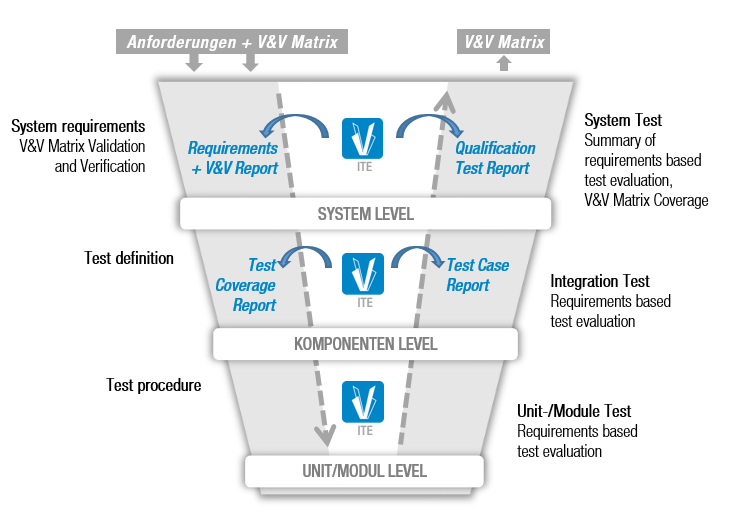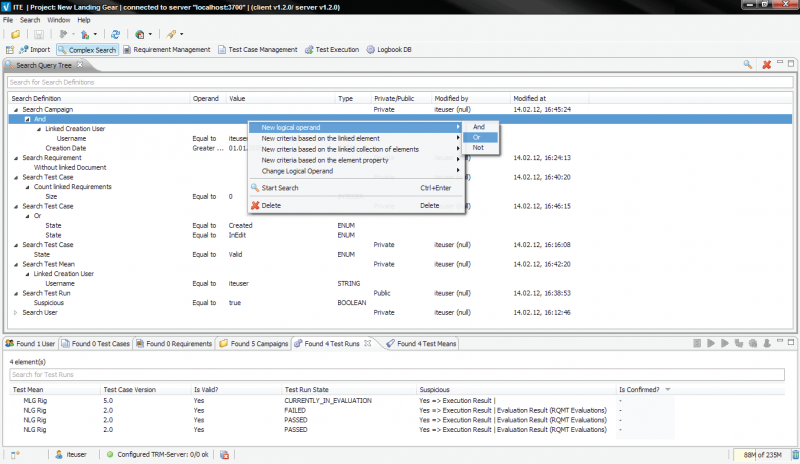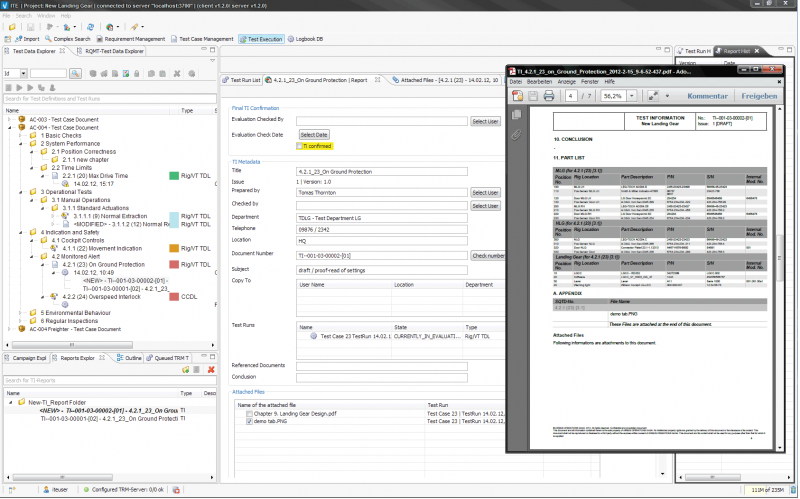
ITE - Integrated Test Environment
Management of complex hardware or software test projects

The Integrated Test Environment (ITE) is our solution to handle complex hardware or software test projects.
ITE provides features to define and manage requirements and test cases in different documents, link them with each other as well as plan tests and test campaigns. Moreover the tests can be developed, executed and evaluated by considering the linked requirements. Test results can additionally be recorded and finally reported in different, adaptable and configurable reports.
Take a look at the following core features and if you miss something or just want to know more about ITE please contact us.

Define, manage and link requirements
ITE provides a basic management of requirements in a document structure. Furthermore it’s possible to import requirements e.g. from DOORS via CVS and XML files. Requirement and validation results can also be exported into XML and ReqIF format. It is possible to define a V&V matrix and link requirements with specific test means.
Trace dependent elements
The whole test chain of dependent elements (requirement, test case, test run and report) is traceable at any time and all elements in a test chain are linked with each other. ITE visualizes the dependencies and helps you to find out which test covers a specific requirement, how it was evaluated and who performed the test in which test environment, etc..

Analyze the impact
Changes in requirements, test cases or test runs will be marked at the dependent elements in the test chains. Each team member can immediately see which elements are affected by the change and maybe need an adaption, e.g. if a test needs to be adapted, executed and/or evaluated again due to requirement changes. Changes can be tracked at all process levels, making it easy to keep the entire test process up to date as well as to locate problems resulting from changes.
Define search queries
The advanced search feature makes it easy to find specific information since it allows users to search for almost all elements, including linked/dependent elements and other attributes available in ITE. Pre-defined queries can also be saved on the ITE server as either private or public search templates.

Configure the test environment
The tests may be executed manually (e.g. as a checklist) or automatically (e.g. in our default execution environment which handles tests defined in the Check Case Definition Language (CCDL)).
Logically ITE is independent of the specific execution environment/level - the implementation of the interface to bind different execution environments is adaptable to your needs. ITE provides interfaces (API) to bind your own tool to ITE and push data to and get specific data from ITE.
Evaluate the test results
Once a test run has been executed, the results are available in ITE and ready for evaluation. In the evaluation mode, ITE shows a summary of the test run (e.g. with test definition, test execution/evaluation, test procedure, etc.) and for a CCDL test ITE evaluates the requirements automatically. Users can then evaluate the requirements on the basis of the test results.
Generate test reports
ITE offers different types of automatically created and well-designed test reports in PDF. Detailed configurable reports for one or more test cases, for a whole test program or a specific test campaign can be generated. The meta data of a report can be saved as a template and used for further test reports. Reports generated by ITE are generally accepted by certification authorities.

Request
The new ITE release with new features is available.
Request ITE now
Open the ITE flyer (PDF)
Your benefits
- One installation/one tool to manage the test process
- Working in an integrated test environment keeps all data in one place.
- Efforts to log and manage data as well as to create reports and keep everything up to date are reduced to a minimum.
- By reducing manual tasks to a minimum, the verification process becomes scalable, transparent and less susceptible to errors.
- Staff training is only needed for one environment
- Automated evaluation and reporting save a vast amount of time. The reporting features in ITE easily create commonly accepted reports for authorities
- Using CCDL, the high-level test definition language, test programs can be run on almost any test bench, eliminating the need for native code programming such as C or Python
Versioning
ITE automatically records a history of requirements and test cases when users transfer their version of a requirement or a test case to the ITE server. Naturally an examination of any version of a requirement or test case or the visualization of differences between two versions is possible.
Multi-user functionality
ITE can manage local projects in a standalone installation or remote/server projects which are available for multiple users at the same time in a client-server installation. For the data storage ITE uses Oracle and PostgreSQL data bases.
Check Case Definition Language - CCDL
CCDL makes automated system testing easier by providing a high-level script language to allow test procedures to be defined in a more readable form. As a result, the test engineer does not need any special programming skills to create CCDL test procedures.
